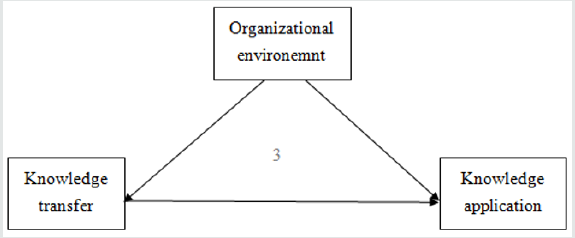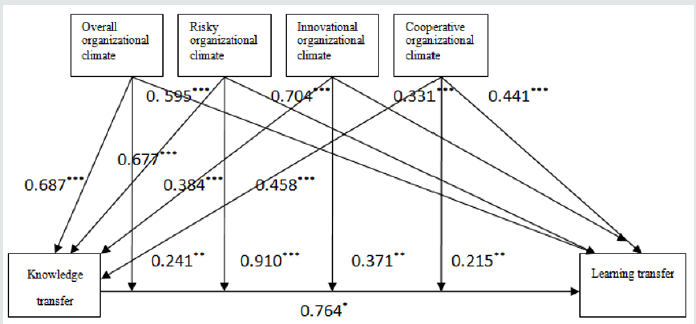
Lupine Publishers Group
Lupine Publishers
Menu
ISSN: 2641-1768
Research ArticleOpen Access
How Organization Climate Moderates the Effect of Knowledge Transfer on Learning Transfer for Adult EMBA Students Volume 4 - Issue 1
Chi-Cheng Chang* and Meng-Chen Tsai
- Department of Technology Application & Human Resource Development, National Taiwan Normal University, Taiwan
Received: April 04, 2020; Published: April 27, 2020
Corresponding author: Chi-Cheng Chang, Department of Technology Application & Human Resource Development, National Taiwan Normal University, No. 162, He-Ping E. Road, Section 1, Taipei, Taiwan
DOI: 10.32474/SJPBS.2020.04.000176
Abstract
The theoretical framework of knowledge management system (KMS) was used to examine the effect of organizational climate and knowledge transfer on learning transfer, and the moderating effects of organizational climate on the influence of knowledge transfer in learning transfer. The participants were 335 EMBA students. Hierarchical regression was employed for confirming the research model. The results showed that organizational climate and knowledge transfer had a significantly positive effect on learning transfer; organizational climate had a significantly positive effect on knowledge transfer; and organizational climate had a positive moderating effect on the influence of knowledge transfer in learning transfer. This study extended the KMS model to include the moderating effect of organizational climate, which was the main contribution of this study.
Keywords: EMBA; Knowledge management system; Knowledge transfer; Learning transfer; Organizational climate
Introduction
According to the knowledge management system (KMS) theory, there exist the relationships among knowledge transfer, organizational environment, and knowledge application [1-5].
The relationships are as follows:
a) Knowledge transfer affects knowledge application.
b) Organizational environment (e.g. facilites, resources,
culture, climate, and system etc.) affects both knowledge
transfer and knowledge application.
However, neither mediating effect nor moderating effect was
demostrated in the KMS. Moreover, if organizational environment
changes to organizational climate and knowledge application
changes to learning transfer, do the relationships above still
exist and how do the relationships demonstrate? The difference
between knowledge application and learning transfer is that
knowledge application is a general concept which is not specified
on the application in workplace, but learning transfer is knowledge
application in workplace. The difference between organizational
environment and organizational climate is that the scope of
organizational environment is wider, while organizational climate
is a type of organizational environment. Thus, this study aims
to examine how the relationships among knowledge transfer,
organizational climate, and learning transfer demonstrate, and
how organizational climate moderates the relationship between
knowledge transfer and learning transfer [6-11].
Previous works were focused on understanding the relationships
among knowledge transfer, organizational environment (or
climate), and knowledge application (or learning transfer) excluding
the understanding of mediating and moderatng effect. Moveover,
previous studies were directed to use by regular employees and
worker as sampling frame. This study is different from others as
it is focused on a better understanding in the relationships among
knowledge transfer, organizational climate, and learning transfer
as well as the moderation role of organizational climate by using
KMS theory and MBA students as sampling frame. The reason why
the MBA students are selected is because, in recent years, Executive
Master of Business Administration (EMBA) has emphasized on
students’ innovative abilities and focused on knowledge transfer
Eisenberg [6]. EMBA has emphasized the training of management toward professions and assisted each student in applying acquired
knowledge in the workplace Gilmore [7]. The purpose of employees
who study executive programs is to acquire professional knowledge
and apply the acquired knowledge in the workplace, meaning that
they can have greater likelihood to perform knowledge transfer
and learning transfer. The study makes conspicuous contributions
in two ways: It makes the KMS theory specify from organizational
environment to organizational climate as well as from knowledge
application to learning transfer (i.e. knowledge application in
workplace). It extends the KMS theory to include the role of
organizational climate on moderating effect.
Theoretical Basis
The KMS theory consists of three constructs: knowledge transfer, knowledge application, and organizational environment which formulate a framework of causal relationships explained as follows.
The KMS theory Figure 1 indicates that knowledge transfer is behavior of knowledge dissemination, which is also the behavior that employees receive education and training. Knowledge application is that employees apply knowledge in the workplace and solve work problems after receiving knowledge transfer [8]. If the efficiency of knowledge transfer is enhanced, then the effectiveness of knowledge application on problem solving will also be raised [9-12]. As a result, knowledge transfer can affect knowledge application [3].
Effects of organizational environment on knowledge application
The KMS theory indicates that organizational environment can facilitate knowledge application [13-15]. Organizational environment means organizational physical resources (e.g. equipment, facility, and space etc.) and non-physical resources (e.g. culture, climate, and system etc.). For those businesses existing in an acute competitive environment, the effect of knowledge application is often determined by the features of the environment [16]. Therefore, organizational environment can affect knowledge application.
Effects of organizational environment on knowledge transfer
The KMS theory indicates organizational environment can support employees to engage in knowledge application [17-20] and make their knowledge become more powerful, which is helpful to knowledge transfer [15]. Hence, organizational environment can affect knowledge transfer [1,13]. According to knowledge application was the core for learning transfer. Knowledge application was substituted by learning transfer, and organizational environment was substituted by organizational climate in this study. It was reasonable to infer that organizational climate and knowledge transfer can simultaneously affect learning transfer.
Hypotheses
Learning transfer and knowledge transfer
Learning transfer is to apply acquired knowledge in a practical situation to solving work problems [21-25]. After stated learning transfer is that people apply acquired knowledge to solving work problems and improving work situations. Knowledge transfer is generally defined that: a) an organizational unit (including a team, department, and person) passes an experience on to other organizational units, meaning that knowledge transfer from a location or person to another location or person; b) knowledge is delivered and exchanged among people, groups, or organizations [26].
Organizational climate
Organizational climate is beliefs and values held commonly by employees. Organizational climate is attributions and expectations that members in an organization held toward organizational activities, which involves employees’ psychological reactions [27- 30]. Organization climate generally includes risk, innovation, and cooperation [31-36]. These three constructs are relevant to learning transfer. Risk for organizational climate refers to beliefs and psychological reactions that employees held when facing uncertainties [25]. Cooperation for organizational climate means that team members are enthusiastic to interact and cooperate frequently to solve work problems [37-40].
Effect of knowledge transfer on learning transfer
Knowledge transfer can affect learning transfer, meaning that an employee delivering or receiving knowledge can apply knowledge in the workplace [41-43]. In other words, knowledge transfer is that employees acquire knowledge through exchanges, which is positive to learning transfer. Learners who internalized knowledge would change his or her cognition and behavior and more likely to apply acquired knowledge [44-47]. Knowledge internalization is helpful to an individual to understand knowledge structure for effectively applying knowledge in the workplace [15,19]. Therefore, knowledge internalization facilitates learning transfer. If an employee holds a positive attitude toward knowledge transfer and is satisfied with that, he or she is more willing to effectively apply knowledge, which facilitates learning transfer. Consequently, employees who are satisfied with knowledge transfer process will have an enhanced effect of learning transfer.
In short, knowledge transfer was selected as an independent variable with Hypothesis 1:
H1 : Knowledge transfer has a positive effect on learning transfer.
H1a : Knowledge internalization has a positive effect on learning transfer.
H1b : Knowledge transfer performance has a positive effect on learning transfer.
Effects of organizational climate on knowledge transfer
Knowledge transfer could be affected by environments [7,12,35]. If an organizational climate remains unopened, employees’ moods will be affected, and the effect of knowledge transfer will also be affected indirectly. If an organization had a good organizational environment, then the employees would effectively exchange knowledge, and the effect of knowledge transfer would be better [28]. In short, overall organizational climate positively affects knowledge transfer. When an organization faced a risk, a greater effect of knowledge transfer would be caused Although knowledge transfer would occur when an organization faced a risk, if the crisis was too small, then knowledge transfer would not occur. Therefore, employees will share knowledge for effectively solving a risk when they perceived that they are in a risky environment. In short, a risky climate can positively affect knowledge transfer. An innovative environment played an important role in employees’ knowledge transfer [5,15]. An innovative environment could facilitate employees’ knowledge transfer because employees could share knowledge with colleagues for innovation to acquire new knowledge [43]. Innovation could facilitate employees’ knowledge transfer [12]. Consequently, innovative climate can positively affect knowledge transfer. A cooperative organizational environment was beneficial to knowledge transfer because employees were more willing to share knowledge in a fair and reciprocal environment, which facilitated knowledge transfer in an organization (Arvanitis, Kubli, & Woerter, 2008). An organization with a cooperative environment was good to knowledge transfer because employees trusted and helped one another in the cooperative environment which facilitated knowledge sharing (Hoffmann, Lopes, & Medeiros, 2014). In short, cooperative organizational climate have a positive effect on knowledge transfer.
Therefore, organizational climate was selected as an independent variable with Hypothesis 2:
H2 : Overall organizational climate has a positive effect on knowledge transfer.
H2a: Risky organizational climate has a positive effect on knowledge transfer.
H2b : Innovative organizational climate has a positive effect on knowledge transfer.
H2c : Cooperative organizational climate has a positive effect on knowledge transfer.
Effects of organizational climate on learning transfer
Organizational climate could affect employees to apply knowledge in the workplace. Hence, employees’ learning transfer can be affected by organizational climate [2,16]. In a risky organizational climate, employees can apply knowledge in the workplace for solutions when they face problems [1]. Thus, risky organizational climate can facilitate employees to apply knowledge in the workplace, which positively affects learning transfer. In an innovative organizational climate, employees can apply knowledge in the workplace or solve problems to create competitive advantages for the organization, which can result in learning transfer [8,7]. In other words, innovative organizational climate can facilitate employees’ innovation and knowledge application, which causes learning transfer. In a cooperative organizational climate, cooperation among organizational members can facilitate an individual’s knowledge application. If the cooperative atmosphere is good, then the organizational employees are more likely to apply knowledge in the workplace [15,46]. Therefore, a cooperative organizational climate promotes organizational members to apply knowledge in the workplace for mission completion and learning transfer facilitation.
Therefore, organizational climate was selected as an independent variable with Hypothesis 3:
H3 : Overall organizational climate has a positive effect on learning transfer.
H3a : Risky organizational climate has a positive effect on learning transfer.
H3b : Innovative organizational climate has a positive effect on learning transfer.
H3c : Cooperative organizational climate has a positive effect on learning transfer.
Moderating effects of organizational climate on the influence of knowledge transfer in learning transfer
Knowledge transfer can affect learning transfer [21,24] and
organizational climate can also affect learning transfer [13]. As
a result, there is probably an interactive effect of knowledge
transfer and organizational climate on learning transfer, which
means either knowledge transfer or organizational climate can be
a moderating variable. On the other hand, organizational climate
can affect knowledge transfer, so organizational climate can be
the moderating variable and can have moderating effect on the
influence of knowledge transfer in learning transfer. When an
organizational environment was changed, the effect of knowledge
transfer on learning transfer would also be changed, meaning that
organizational environments might have a moderating effect on the
influence of knowledge transfer in learning transfer.
In addition, risky, innovative, and cooperative climates can
influence learning transfer respectively, so Hypothesis 4 can be
sustained:
H4 : The effect of knowledge transfer on learning transfer can be moderated by overall organizational climate.
H4a : The effect of knowledge transfer on learning transfer can be moderated by risky organizational climate.
H4b : The effect of knowledge transfer on learning transfer can be moderated by innovative organizational climate.
H4c : The effect of knowledge transfer on learning transfer can be moderated by cooperative organizational climate.
Method
Participants and sampling
There were 164 EMBA programs, with a total of 7924 students, at 63 universities in Taiwan (Ministry of Education, 2014). Four-hundred-fifty students were randomly selected from each university based on the samples’ proportions to respond to the questionnaire. There was a total of 335 valid returned questionnaires. The response rate is about 74.4%. The number of the returned questionnaire met the following standard and thus, the sample could represent the population.
Ns = (Np) (p) (1-p) / [ (Np-1) (B/C)2 + (p) (1-p) a) where: a) Ns = the completed sample size needed for the desired level of precision.
b) Np is the size of the population, which is 7924 in this study.
c) (p) (1-p) is the proportion of the population expected to choose one of the two response categories. Namely, when the size of population is 8000, the difference in population can be 0.8 and 0.2.
d) B is margin of error, which is normally set to be ±0.05 and.
e) C is Z-score associated with the confidence level, which is 1.96 corresponding to the 95% confident level. After the calculation, a minimum of 238 returned questionnaires was required for representing population.
The sample averaged 38 years in age and had nine years of experience in computer. The sample consisted of 48% males and 52% females. Eighty-five percent gained university degree. Meanwhile, 58% have got married and 49% were managerial positions.
Research framework
The research framework is shown in Figure 2. Hierarchical regression was employed to examine effects of knowledge transfer and organizational climate on learning transfer, effect of organizational climate on knowledge transfer, as well as moderating effects of organizational climate on the influence of knowledge transfer in learning transfer.
Instrument
All the items in the three scales were based on a 7-point Likerttype scale with response options from 1 (extremely disagree) to 7 (extremely agree).
Learning transfer
A scale for learning transfer, with a total of five items, developed was employed. The scale measured how employees in an organization apply knowledge in the workplace. The five items are listed in the following:
a. I can apply what I learn from the EMBA curriculum in the
workplace.
b. As long as I learn from the EBMA curriculum, I will be able
to apply what I learn in my work.
c. My work performance can be improved if I can apply what
I learn from the EMBA curriculum in the workplace.
d. My work performance is improved because I have applied
what I learned from the EMBA curriculum.
e. I can apply new knowledge learned from the EMBA
curriculum to enhance my work performance.
Knowledge transfer
The knowledge transfer scale developed by Li and Hsieh (2009)
was adopted. There are two constructs in the scale, which are: a)
knowledge internalization with nine items; and b) knowledge
transfer performance with six items.
The construct of knowledge internalization in the scale
measured employees’ behavior changes after receiving or delivering
knowledge and whether the knowledge become to be their own
knowledge. On the other hand, the construct of knowledge transfer
performance measured the performance on the process of receiving
and deliving knowledge.
The items for knowledge internalization are listed as below:
a. Delivering knowledge to others makes me re-inspect the
sufficiency of my knowledge.
b. Delivering knowledge to others makes me reflect the
appropriateness of my knowledge.
c. Delivering knowledge to others also makes me update my
knowledge.
d. Receiving knowledge from others makes me re-organize
my knowledge.
e. Receiving knowledge from others makes me re-construct
my knowledge.
f. Receiving knowledge to others makes me improve my
knowledge.
1. The items for knowledge transfer performance
are listed as the following:
a) I am very willing to deliver or receive knowledge from
others.
b) I am satisfied with the outcome of delivering or receiving
knowledge from others.
c) Knowledge that is acquired from the curriculum meets
my needs.
d) Knowledge that is acquired from the curriculum is helpful
to my course work.
e) Knowledge that is acquired from the curriculum is
positive to the enhancement of my study achievement.
f) Knowledge that is acquired from the curriculum is
beneficial to my study efficiency.
Organization climate
The organization climate scale developed by Janz and
Prasarnphanich (2003) and Chen and Huang (2009) was adopted.
The risky organization climate scale done contained five items. The
scale measured the reactions when an organization faced risks and
decisions. The items are listed as follows:
a. For making the most profit, the company is very prudent
when making decisions.
b. The company is very willing to allow us to provide
suggestions toward challenges.
c. The businesses in the company are established based on
the appropriate evaluations about the risks.
d. The philosophy of the management in the company is the
rapid progress on work performance.
e. Sometimes, the company faces big troubles, but these
troubles make us develop competitiveness.
The innovative and cooperative climate scale developed by [13]
contained six items. The innovative organizational climate scale
measured employees’ work environment to see if it had innovative
mechanisms, whereas the cooperative organizational climate scale
measured that whether employees assist one another.
The items for innovative organizational climate are listed as the
following:
a. The company provides an incentive environment to
facilitate innovations.
b. The company encourages the employees to innovate.
c. The company actively pushes for innovation.
d. The employees in the company support one another.
e. The employees in the company hold a sense of security
during the cooperation.
f. I can obtain assistances from the supervisor and colleague
when I ask for teamwork.
Reliability and validity
Convergent validity is AMOS was employed for Confirmatory Factor Analyses (CFA). Factor loadings for each item were between .590 and .965, which were higher than .50, indicating that each item had a good internal quality. Composite Reliability (CR) and Average Variance Extracted (AVE) were used to examine converge validity for each construct. The CR values for all the constructs were higher than .60 and AVE values were higher than .50, showing that the scale had a high convergent validity (Shiu, Pervan, Bove, & Beatty, 2011).
Discriminant validity
The diagonal lines in correlation matrix among constructs were the Square Root of AVE (SRAVE) of all the constructs. Each construct’s SRAVE was higher than the correlation coefficients between any two constructs, so each construct had a good discrimination validity.
Reliability
Cronbach’s α for all the constructs in the scales were higher than .80, which was good. Guttman coefficients and split-half reliability were higher than .70, which was acceptable.
Model fit
The χ2 for the research model was 533.916 (p=0.000), Goodness of Fit Iindex (GFI) was .904, Comparative Fit Index (CFI) was .977, and Normal Fit Index (NFI) was .944, which were all greater than .900. Furthermore, Root Mean Square Error of Approximation (RMSEA) was .045, which was smaller than .08. In short, these data revealed that the model had a satisfied goodness of fit [24].
Results
Effects of knowledge transfer on learning transfer
Model 1 shown in Table 1 revealed that knowledge transfer had a significantly positive effect on learning transfer (β = .764, p = .000), and the power of regression model (Adj R2 = 58.2%) was significant (F = 465.759, p < .001). Hence, Hypothesis 1 was sustained. Model 2 and 3 shown revealed that both knowledge internalization and knowledge transfer performance had a significantly positive effect on learning transfer. The effect of knowledge internalization (β = .730, p = .000) was greater than the effect of knowledge transfer performance (β = .713, p = .000). Both powers of regression model (Adj R2= 53.1%, 50.7%) were significant (F = 379.087, 345.115, p < .001). Hence, Hypothesis 1a and 1b were sustained.
Table 1: Regression analysis about the effect of knowledge transfer and organizational climate on learning transfer.
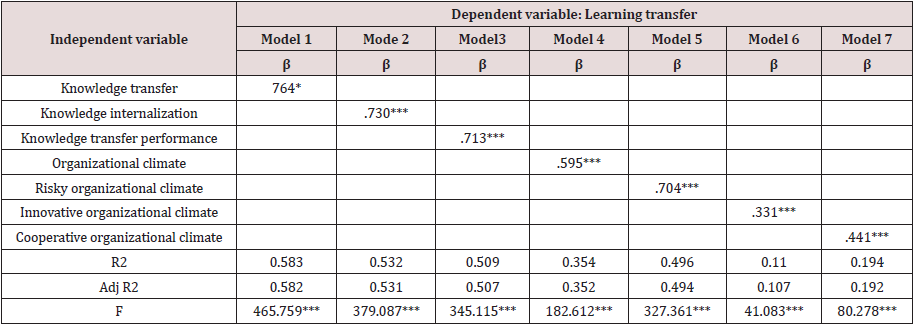
*** p < .001
Effects of organizational climate on knowledge transfer
Model 1 to 4 shown in Table 2 revealed that overall organizational climate, risky organizational climate, innovative organizational climate, and cooperative organizational climate had a significantly positive effect on knowledge transfer. The effects ordered from the greatest to the smallest were: overall organizational climate (β =0.687, p = .000), risky organizational climate (β = 0.677, p = .000), cooperative organizational climate (β = 0.458, p = .000), and innovative organizational climate (β = 0.384, p = .000). Besides, the powers of regression model (Adj R2= 47.1%, 45.6%, 14.5%, 20.6%) were significant (F= 298.000, 281.530, 57.538, 87.583, p < .001). Hence, Hypothesis 2, 2a, 2b, and 2c were sustained.
Table 2: Regression analysis about the effect of organizational climate on knowledge transfer.

*** p < .001
Effects of organizational climate on learning transfer
Model 4 to 7 shown in Table 1 revealed that organizational climates had significantly positive effects on learning transfer. The effects ordered from the greatest to the smallest were: risky organizational climate (β = 0.704, p = .000), cooperative organizational climate (β = 0.441, p = .000)), and innovative organizational climate (β = 0.331, p = .000). Besides, the powers of regression model (Adj R2=35.2%, 49.4%, 10.7%, 19.2%) were significant (F=182.612, 327.361, 41.083, 80.278, p < .001). Hence, Hypothesis 3, 3a, 3b, and 3c were sustained.
Moderating effects of organizational climate
Moderating effects of organizational climate on the influence of knowledge transfer in learning transfer Model 1 shown in Table 3 revealed that knowledge transfer had a significantly positive effect on learning transfer. Model 2 showed that knowledge transfer and organizational climate had significantly positive effects on learning transfer (β = 0.636, 0.186, p = .000), and the powers of regression model (Adj R2 = 59.9%) was significant (F=250.339, p < .001), which was about 1.8% higher than Model 1 (Δ R2). Model 3 showed that the interaction between knowledge transfer and organizational climate was significant (β = 0.241, p < .01), and the powers of regression model (Adj R2 = 60.9%) was also significant (F=174.247, p < .001), which was about 1.1% higher than Model 2 (Δ R2). The results indicated that organizational climate had a significantly moderating effect on the influence of knowledge transfer in learning transfer. Therefore, Hypothesis 4 was sustained. As shown in Figure 3, the moderating effect was positive.
Figure 3:Moderating effects of organizational climate on the influence of knowledge transfer in learning transfer.
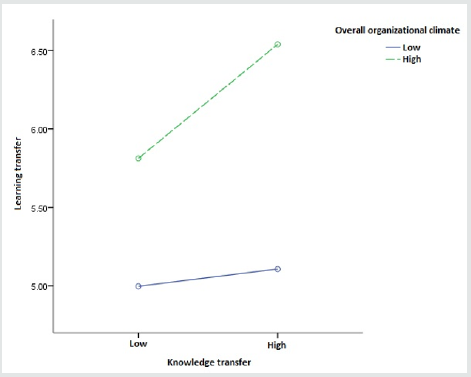
Table 3: Regression analysis about the effect of knowledge transfer and organizational climate on learning transfer.
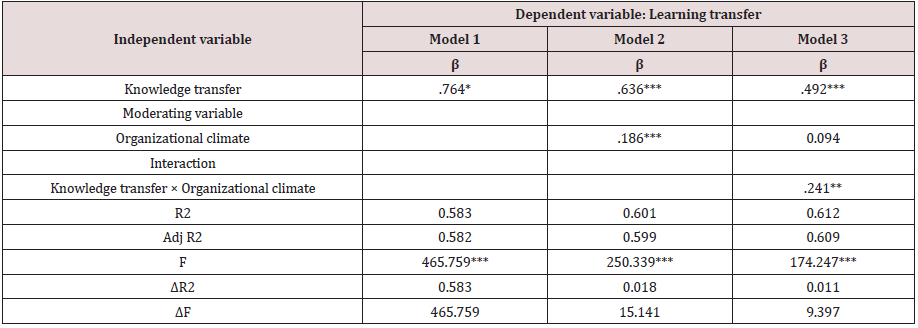
* p < .05, ** p < .01,*** p < .001
Moderating effects of risky, innovative, cooperative organizational climate on the influence of knowledge transfer in learning transfer : The first Model 2 shown in Table 4 revealed that risky organizational climate had a significantly positive effect on learning transfer (β = 0.408, p = .000). The first Model 3 revealed that the interaction between knowledge transfer and risky organizational climate was significant (β = 0.910, p = .000), and the powers of regression model (Adj R2 = 63.6%) was also significant (F=195.463, p < .001). Therefore, Hypothesis 4a was sustained. Risky organizational climate had a significantly moderating effect on the influence of knowledge transfer in learning transfer. As shown in Figure 4, the moderating effect was positive. As the second Model 2 and 3 shown in Table 4, Hypothesis 4b was sustained. Innovative organizational climate had a moderating effect on the influence of knowledge transfer on learning transfer. According to Figure 5, the moderating effect was positive. As the third Model 2 and 3 shown in Table 4, Hypothesis 4c was sustained. Cooperative organizational climate had a moderating effect on the influence of knowledge transfer in learning transfer. According to Figure 6, the moderating effect was positive.
Table 4: Regression analysis about the effect of knowledge transfer and organizational climate on learning transfer.
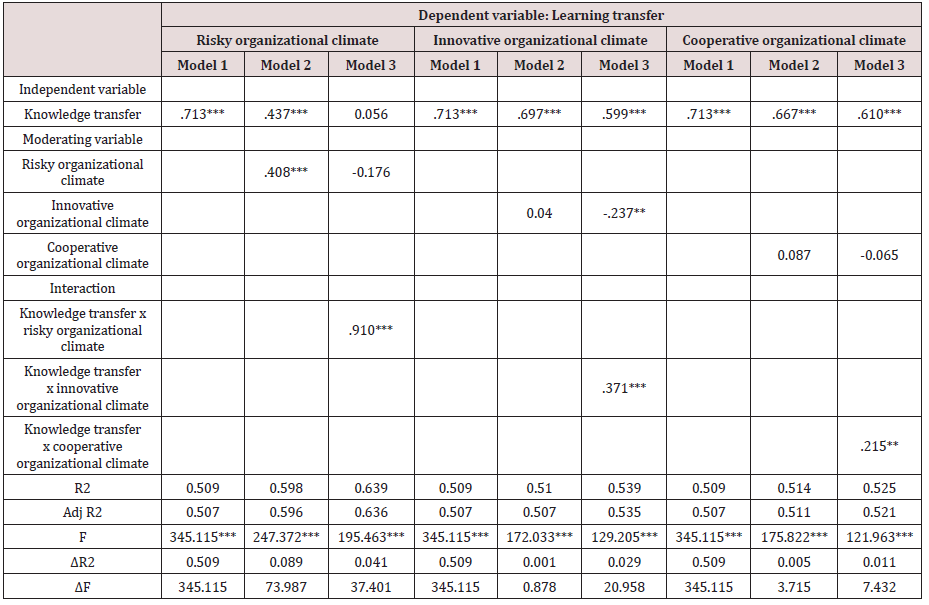
*** p < .001, ** p < .01
Figure 4: Moderating effects of risky organizational climate on the influence of knowledge transfer in learning transfer.
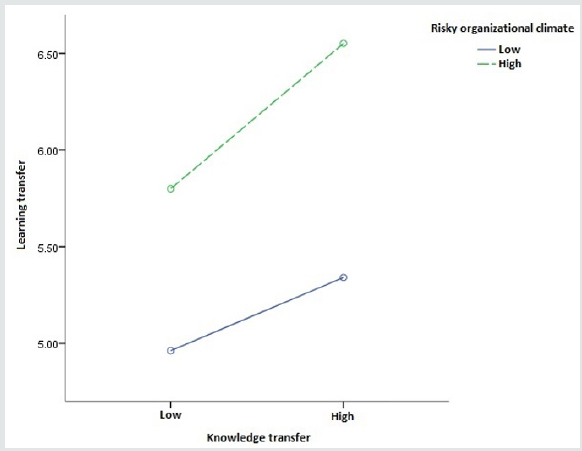
Figure 5: Moderating effects of innovative organizational climate on effects of knowledge transfer on learning transfer.
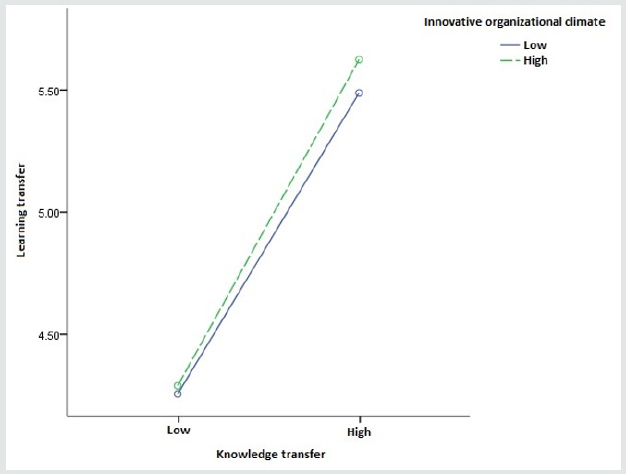
Figure 6: Moderating effects of cooperative organizational climate on effects of knowledge transfer on learning transfer.
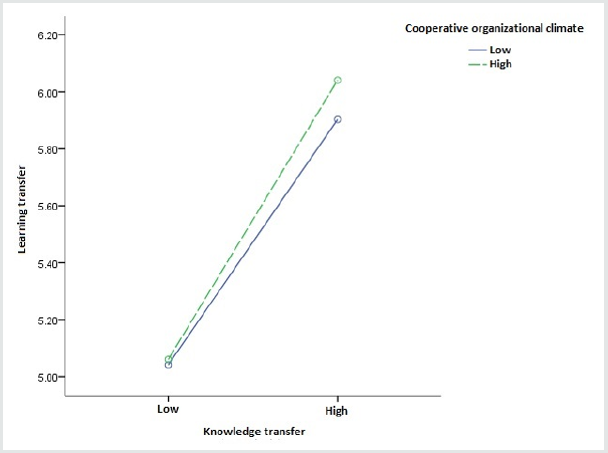
Discussions
Knowledge transfer affects learning transfer
This study revealed that overall knowledge transfer, knowledge internalization, and knowledge transfer performance had a significantly positive effect on learning transfer. In other words, success of knowledge transfer among organizational members was helpful to learning transfer. argued that knowledge transfer enhanced knowledge application in the workplace, which is consistent with that of this study. This study was also consistent with the viewpoints that knowledge transfer can facilitate employees to apply knowledge in the workplace [15,30]. The KMS theory emphasizes that knowledge transfer can facilitate knowledge application, meaning that effective knowledge transfer can assist employees to apply knowledge in practical work. Furthermore, this study also found that if organizational employees could internalize knowledge and were satisfied with knowledge transfer, then the effect of knowledge transfer on learning transfer would be more significant. Effective knowledge transfer can be influenced by knowledge itself [5,12]. The present study showed that learning transfer was affected by knowledge transfer. Consequently, learning transfer can be influenced by learning itself. Applying knowledge and skills to solving work problems for enhancing work performance, employees must engage in learning [23]. However, not all the employees could achieve a successful learning transfer. Therefore, employees’ individual characteristics and learning status can also influence learning transfer [8, 7].
Organizational climate affects knowledge transfer
This study found that overall organizational climate had a significantly positive effect on knowledge transfer. The result was consistent with the findings that if a company’s overall organizational climate was beneficial to employees’ sharing and knowledge exchange behavior and was provided a platform or a way for employees to engage in knowledge transfer, then it was helpful to solve work problems and create work performance [4,7]. Risky organizational climate had a significantly positive effect on knowledge transfer. The result was consistent with the findings that when an organization faced uncertainties or risks, employees would acquire knowledge and skills as well as engagement in exchanges and interactions to solve problems, which would lead to knowledge transfer [16,19]. Therefore, when an organization’s uncertainty or risk is great, the effect of knowledge transfer is better. Innovational organizational climate had a significantly positive effect on knowledge transfer. The result was consistent with the findings that under innovative organizational environment, employees would be more willing to improve innovations on products, procedures, and services through knowledge exchanges and brainstorming to enhance performance [24]. Cooperative organizational climate had a significantly positive effect on knowledge transfer. The result was consistent with the findings that when employees worked in a fair, harmonious, cooperative, and trust environment, they were more willing to share acquired knowledge and held a positive attitude toward work problems and errors by solving problems together [11].
Organizational climate affects learning transfer
This study found that overall organizational climate had a significantly positive effect on learning transfer. The result was consistent with the findings that organizational climate was beneficial to learning transfer [14], and organizational climate could affect employees’ knowledge application in the workplace. Risky organizational climate had a significantly positive effect on learning transfer. The result was consistent with the findings that with a high risky organizational climate, employees tended to work hard to apply knowledge in work to solving problems. Therefore, when an organization faces difficulties, organizational members will be more willing to apply knowledge in work to solve work problems. Cooperative organizational climate had a significantly positive effect on learning transfer. The result was consistent with the findings that innovative organizational climate could facilitate employees to apply knowledge in work. When the organizational climate facilitated employees to innovate, employees would work hard to apply knowledge in innovations to complete innovations for products or services. Cooperative organizational climate was helpful to knowledge application in work. An organization with a fair atmosphere would lead members to holding a positive attitude on exchanging knowledge with others [1,9]. Consequently, organizational employees can also cooperate and share knowledge with others to solve problems together and enhance organizational competitiveness. No matter whether organizational environment can affect learning transfer, it is very important that employees, with different environments, can apply knowledge in work [5,12].
Moderating effects of organizational climate on the influence of knowledge transfer in learning transfer
This study showed that overall, risky, innovative, and cooperative organizational climate had a moderating effect on the influence of knowledge transfer in learning transfer. The research model is shown in Figure 7. The research model is consistent with KMS theory. The theory refers to that knowledge transfer affects knowledge application, and organizational environment affects knowledge application and knowledge transfer. Due to different organizational environments, knowledge transfer would also affect learning transfer differently. Therefore, an organization with a clear climate is helpful to employees to exchange knowledge and apply knowledge in practical work. Furthermore, when an organizational climate is clear, the effectiveness for employees to exchange and apply knowledge in work is high. When an organization faced an uncertainty, both organization and organizational members would also feel pressed. Organizational members were more likely to ask for exchanges and sharing important knowledge with others [40].
When difficuties and pressures were bigger, the possibility for immediately applying acquired knowledge from exchanges was high, which was confirmed by this study that risky organizational climate had a positive moderating effect for the influence of knowledge transfer on learning transfer.The result was consistent with that under an innovative organizational climate, when the effect of knowledge transfer was good, then the possibility of knowledge application was high [21]. Employees must continuously exchange knowledge and apply knowledge in innovations to reach an innovation. As a result, with a high innovative level of organizational climate, the level for employees to transfer knowledge is high, which leads to a better learning transfer. When an organizational employee was willing to share knowledge with others, he or she was more likely to apply knowledge in the workplace. The result of this study was consistent with that when the cooperative level of organizational climate was high, the effect of knowledge transfer on learning transfer was high [31,20]. Employees tended to apply knowledge to work after acquiring effective knowledge because they wanted to improve their performance.
Conclusion
Contributions and implications for theory
A relation model of organizational climate, knowledge transfer, and learning transfer was proposed in this study based on a theoretical framework of a KMS. The result revealed that all the 11 hypotheses were sustained. The model not only made KMS theory focus form organizational environment and knowledge application to organizational climate and learning transfer respectively but also presented the moderating effect of organizational climate which was a significant contribution. Organizational climate positively moderated the effect of knowledge transfer on learning transfer. When organizational climate was high, it strengthened the effect of knowledge transfer on learning transfer. In contrast, when organizational climate was low, it weekend the effect of knowledge transfer on learning transfer. The results of this study about the effect of knowledge transfer on learning transfer can be a reference for creating curriculum in on-the-job training program and an encouragement for instructors and students to focus on learning activities of knowledge transfer and learning transfer. For industries, the results of this study revealed that organizational climate affected knowledge transfer and learning transfer. In other words, it can be a basis for management practices which lets employers be able to determine which organizational climate to build to facilitate employees to apply knowledge in work.
Implications for practice
Using knowledge transfer to enhance employees’ learning transfer
This study revealed that knowledge transfer could positively affect learning transfer, so employers should support employees to engage in knowledge transfer and encourage them to apply knowledge in work for achieving the effect of learning transfer. Employers should also arrange employees to engage in advanced studies because both employees and organization can be developed. Knowledge transfer, knowledge internalization, and knowledge transfer performance had a significantly positive effect on learning transfer. Thus, if employers want to enhance the effect of learning transfer, they need to encourage employees to transfer knowledge. Besides, employers also need to assist employees to internalize acquired knowledge as their own knowledge and let them be satisfied with knowledge because the effect of knowledge transfer on learning transfer can be improved.
Creating an organizational climate that is beneficial to knowledge transfer
This study revealed that overall organizational climate had a significantly positive effect on knowledge transfer. Hence, employers not only need to understand employees’ feelings toward organizational climate, but also need to create an organizational climate that is beneficial to knowledge transfer to make employees be willing to engage in knowledge transfer. This study also found that risky organizational climate had a positive effect on knowledge transfer. Thus, when an organization faces a risky climate, employers not only need to understand the difficulties faced by employees, but also need to make sure whether employees have sufficient knowledge to solve problems. Employers are also required to encourage employees to exchange knowledge, so that employees can acquire desired knowledge. Innovational organizational climate had a significantly positive effect on knowledge transfer. Thus, employers not only need to encourage employees to innovate, but also need to provide an appropriate environment for encouraging them to enhance creativity. This study also revealed that cooperative organizational climate had a positive effect on knowledge transfer. Therefore, employers should create an environment for employees to cooperate mutually to enhance work performance. Employers should take interpersonal relationship into consideration and create a fair work environment to enhance the effect of knowledge transfer in the organization.
Supporting an organizational climate that facilitates learning transfer
This study showed that overall organizational climate had a significantly positive effect on learning transfer, meaning that employers are required to focus on the establishment of organizational climate by making employees feel that the organizational climate supports their work. Thus, the employees will be more willing to apply knowledge in work. Risky organizational climate had a significantly positive effect on learning transfer, indicating that when an organization encounters difficulty, employees are more likely to apply knowledge in work for achieving the purpose of learning transfer. Therefore, employers should sufficiently tell employees the difficulties they faced. As a result, employees can apply knowledge in work for solving difficulties faced by the organization. Innovative organizational climate had a significantly positive effect on learning transfer. Learning through EMBA is helpful to the cultivation of innovative ability, which makes an organization become more innovative and enhance the effect of innovative organizational climate on learning transfer. Cooperative organizational climate had a significantly positive effect on learning transfer. Thus, employers should create a cooperative organizational climate that makes employees be willing to cooperate. Mangers should treat members fairly. In consequence, employees are willing to apply knowledge in teamwork, which can enhance the effect of learning transfer.
Enhancing different types of organizational climate for improving the effect of knowledge transfer on learning transfer
This study indicated that overall organizational climate had a significantly positive moderating effect on the influence of knowledge transfer in learning transfer, meaning that employers should enhance organizational climate for employees to transfer knowledge with colleagues and apply knowledge in work. Hence, the effect of knowledge transfer on learning transfer will be great. Risky organizational climate had a significantly positive moderating effect on the influence of knowledge transfer in learning transfer, showing that when an organization faces uncertainties, employers should enhance risky climate for employees to apply knowledge in work risks, which helps the organization overcome difficulties. Therefore, the effect of knowledge transfer on learning transfer will become great. Innovative and cooperative organizational climate had a significantly positive moderating effect on the influence of knowledge transfer in learning transfer. As a result, employers should effectively promote innovative organizational climates because employees will be willing to exchange and transfer knowledge with one another and apply knowledge in work. Employers should also promote cooperative organizational climates because with a fair atmosphere, employees are willing to cooperate and transfer knowledge and apply knowledge to solving work problems together. Thus, the effect of knowledge transfer on learning transfer will become great [47].
Limitations and future studies
The sample in this study was EMBA students, so the study results might not be generalized to non-MBA students. For future studies, mediating effects of knowledge transfer on the influence of organizational climate in learning transfer can be examined. Incorporating the result of the study, a moderated mediation model can be further developed.
References
- Allen DA, Hyde J, Leslie LK(2012) I don't know what they know: Knowledge transfer in mandated referral from child welfare to early intervention. Children and Youth Services Review 34(5): 1050-1059.
- Arvanitis S, Kubli U, Woerter M (2008) University-industry knowledge and technology transfer in Switzerland: What university scientists think about co-operation with private enterprises. Research Policy37(10): 1865-1883.
- Asif F(2011) Estimating the impact of denison's, what is the difference between organizational culture and organizational climate? A native's point of view on a decade of paradigm wars. Journal of Business Research 64(5): 454-459.
- Awad EM, Ghaziri HM(2004)Knowledge management (1st),New York, NY: Person Educaiton, New York, USA.
- Baartman LKJ, Bruijn ED(2011) Integrating knowledge, skills and attitudes: Conceptualising learning processes towards vocational competence. Educational Research Review 6(2): 125-134.
- Eisenberg J, Lee HJ, Bruck F, Brenner B, Claes MT, et al. (2013) Can business schools make students culturally competent? Effects of cross-cultural management courses on cultural intelligence. Academy of Management Learning & Education 12(4): 603-621.
- Gilmore LM (2007) Kennesaw state university’s EMBA coaching program: Determining the benefits to students, coaches and the university.Unpublished doctoral dissertation, Capella University, Minnesota.
- Butler T, Feller J, Pope A, Emerson B, Murphy C(2008) Designing a core IT artefact for knowledge management systems using participatory action research in a government and a non-government organization. Journal of Strategic Information Systems 17: 249-267.
- Chen CJ, Huang JW(2007) How organizational climate and structure affect knowledge management: The social interaction perspective. International Journal of Information Management 27(2): 104-118.
- Chen CJ, Hsiao YC, Chu MA (2014) Transfer mechanisms and knowledge transfer: The cooperative competency perspective. Journal of Business Research 67(12): 2531-2541.
- Cheng H, Lu YC, Sheu C(2009) An ontology-based business intelligence application in a financial knowledge management system. Expert systems with applications 36(2): 3614-3622.
- ChiNW, Chung YY, TsaiWC (2011) How do happy leaders enhance team success? The mediating roles of transformational leadership, group affective tone, and team processes. Journal of Applied Social Psychology41(6): 1421-1425.
- Cress U, Kimmerle J(2008) Endowment heterogeneity and identifiability in the information-exchange dilemma. Computers in Human Behavior 24(3):862-874.
- Ewers MC(2013) From knowledge transfer to learning: The acquisition and assimilation of human capital in the United Arab Emirates and the other Gulf States. Geoforum 46(3): 124-137.
- Gil Y, Lee SBJ(2003) Integration model of technology internalization modes and learning strategy: globally late starter Samsung’s successful practices in South Korea. Technovation 23(4): 333-347.
- Gunawardena CN, LinderVanBerschot JA, LaPointe DK, Rao L(2011) Predictors of learner satisfaction and transfer of learning in a corporate online education program. American Journal of Distance Education 24(4): 207-226.
- Hammami H, Amara N, Landry R (2013) Organizational climate and its influence on brokers’ knowledge transfer activities: A structural equation modeling. International Journal of Information Management 33: 105-118.
- Herrera L, Maria FMD, Nieto M(2010) Mobility of public researchers, scientific knowledge transfer, and the firm's innovation process. Journal of Business Research 63(5): 510-518.
- Hoffmann VE, Lopes GSC, Medeiros JJ (2014) Knowledge transfer among the small businesses of a Brazilian cluster. Journal of Business Research 67(5): 856-864.
- Hossain N, Sarkani S, Mazzuchi TA(2012) The integration and impact of effective knowledge management systems in the advancement of the decisionmaking process in complex organizations to realize economic growth. Procedia Computer Science 8: 100-105.
- Hupp JM, Sloutsky VM(2011) Learning to learn: From within-modality to cross-modality transfer during infancy. Journal of Experimental Child Psychology 110: 408-421.
- Hurt U,Otto T, Kaare KK, Koppel O (2014) New approach to knowledge transfer environment development. Procedia Engineering 69: 273-281.
- Janz BD, Prasarnphanich P(2003) Understanding the antecedents of effective knowledge management: The importance of a knowledge-centered culture. Decision Sciences34(2): 351-384.
- Jiang ZS (2012) Research on efficiency of knowledge transfer in technical innovation alliances. Physics Procedia 25: 1947-1954.
- Kang Y, Wen Y, Zhou Q(2012) A mode of combined ERP and KMS knowledge management system construction. Physics Procedia 25: 2228-2234.
- Klenk M, Forbus K (2009) Analogical model formulation for transfer learning in AP physics. Artificial Intelligence 173(18): 1615-1638.
- Koçer B, Arslan A (2010)Genetic transfer learning. Expert Systems with Applications 37: 6997-7002.
- Levin DZ, Kurtzberg TR, Phillips KW, Lount BR(2010) The Role of affect in knowledge transfer. Group Dynamics: Theory, Research, and Practice 14(2): 123-142.
- Li CY(2012) Knowledge stickiness in the buyer-supplier knowledge transfer process: The moderating effects of learning capability and social embeddedness. Expert Systems with Applications 39(5): 5396-5408.
- Li CY, Hsieh CT(2009) The impact of knowledge stickiness on knowledge transfer implementation, internalization, and satisfaction for multinational corporations. International Journal of Information Management 29(6): 425-435.
- Lin TC, Wu S, Lu CT (2012) Exploring the affect factors of knowledge sharing behavior: The relations model theory perspective. Expert Systems with Applications 39(1): 751-764.
- Liao SH, Hu TC (2007) Knowledge transfer and competitive advantage on environmental uncertainty: An empirical study of the Taiwan semiconductor industry. Technology Innovation 27(6-7): 402-411.
- López VM, Carrillo MO, Bustament TP (2013) Technological knowledge framework towards organizational knowledge transfer in Mexico. Social and Behavioral Sciences 73: 556-563.
- Marabelli M, Newell S(2012) Knowledge risks in organizational networks: The practice perspective. Journal of Strategic Information Systems 21(1): 18-30.
- Martinsons MG(1995) Strategic management roads for knowledge-based systems success.Computers in Industry 26(2): 193-195.
- Mei S(2012) Multi-kernel transfer learning based on Chou’s PseAAC formulation for protein submitochondria localization. Journal of Theoretical Biology 293: 121-130.
- (2014)Ministry of Education. The studying rate for each major among graduate students studying for master's degree
- Pan SL, Yang Q(2010) A Survey on transfer learning. IEEE Transactions on Knowledge and Data Engineering 22(10): 1345-1359.
- Palomar E, Alcaide A, Ribagorda A, Zhang Y (2012)The peer’s dilemma: A general framework to examine cooperation in pure peer-to-peer systems. Computer Networks 56(17): 3756-3766.
- Shiu E, Pervan SJ, Bove LL, Beatty SE (2011) Reflections on discriminant validity: Reexamining the Bove et al. (2009) findings. Journal of Business Research 64(5): 497-500.
- Trkman P, Desouza KC (2012) Knowledge risks in organizational networks: An exploratory framework. Journal of Strategic Information Systems 21(1): 1-17.
- Tsou W, Chen F (2014) ESP program evaluation framework: Description and application to a Taiwanese university ESP program. English for Specific Purposes 33: 39-53.
- Vie OE (2012) The need for knowledge integration in renewable energy innovation projects. Energy Procedia 20: 364-376.
- Wang TG, Lin CL, Jiang J, Klein G (2007)Improving enterprise resource planning (ERP) fit to organizational process through knowledge transfer. International Journal of Information Management 27(3): 200-212.
- Weidenfeld A, Williams AM, Butler RW(2010) Knowledge transfer and innovation among attractions. Annals of Tourism Research 37(3): 604-626.
- Yusr M, Othman AR, Mokhtar SSM (2012) Assessing the relationship among six sigma, absorptive capacity and innovation performance. International Congress on Interdisciplinary Business and Social Science 65: 570-578.
- Zhao J, Qi Z, Pablos POD (2014) Enhancing enterprise training performance: Perspectives from knowledge transfer and integration. Computers in Human Behavior 30: 567-573.

Top Editors
-

Mark E Smith
Bio chemistry
University of Texas Medical Branch, USA -

Lawrence A Presley
Department of Criminal Justice
Liberty University, USA -

Thomas W Miller
Department of Psychiatry
University of Kentucky, USA -

Gjumrakch Aliev
Department of Medicine
Gally International Biomedical Research & Consulting LLC, USA -

Christopher Bryant
Department of Urbanisation and Agricultural
Montreal university, USA -

Robert William Frare
Oral & Maxillofacial Pathology
New York University, USA -

Rudolph Modesto Navari
Gastroenterology and Hepatology
University of Alabama, UK -

Andrew Hague
Department of Medicine
Universities of Bradford, UK -

George Gregory Buttigieg
Maltese College of Obstetrics and Gynaecology, Europe -

Chen-Hsiung Yeh
Oncology
Circulogene Theranostics, England -
.png)
Emilio Bucio-Carrillo
Radiation Chemistry
National University of Mexico, USA -
.jpg)
Casey J Grenier
Analytical Chemistry
Wentworth Institute of Technology, USA -
Hany Atalah
Minimally Invasive Surgery
Mercer University school of Medicine, USA -

Abu-Hussein Muhamad
Pediatric Dentistry
University of Athens , Greece

The annual scholar awards from Lupine Publishers honor a selected number Read More...




